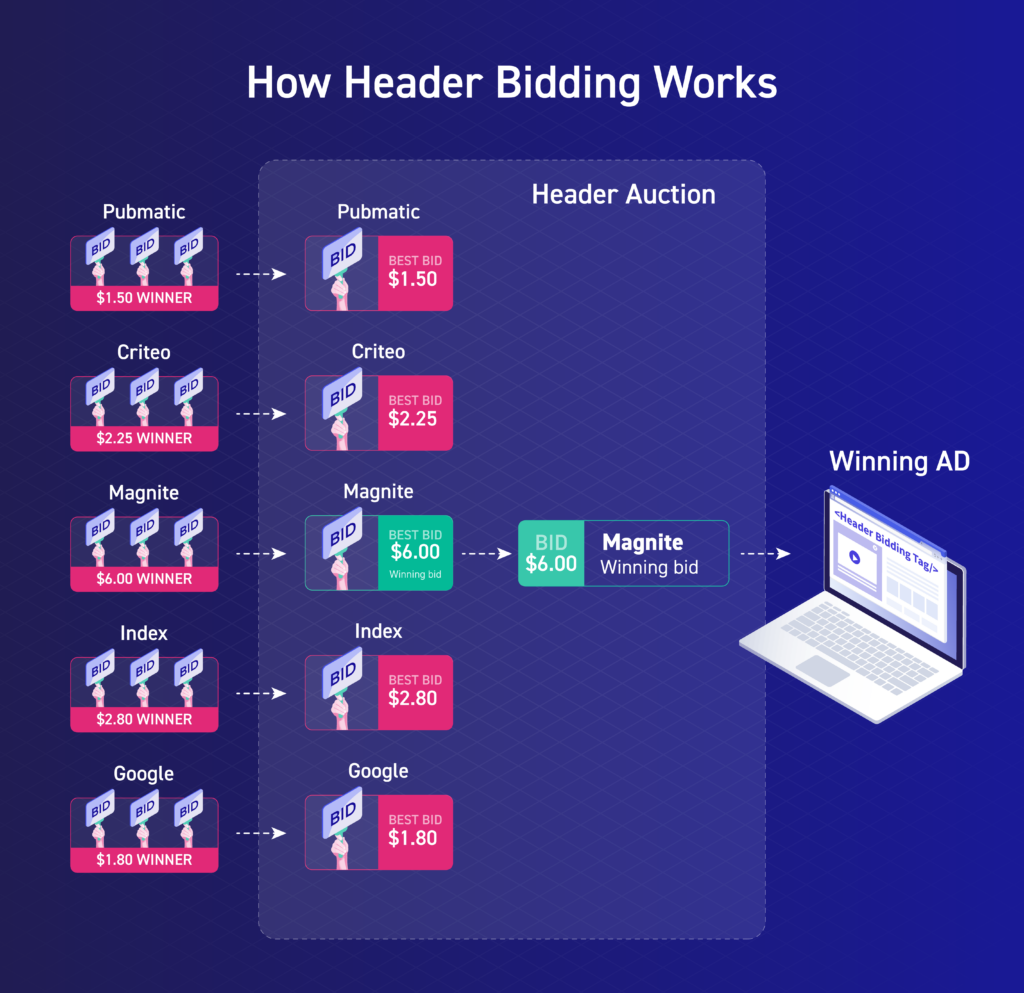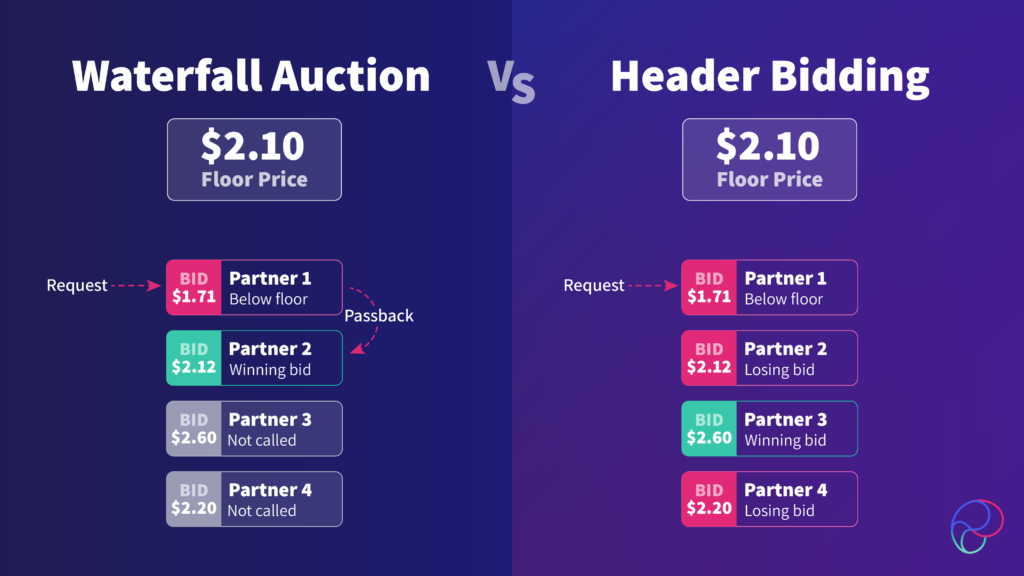What Is Header Bidding and Why It Matters for Publishers

Header bidding is one of the most talked-about concepts in the programmatic advertising and adtech industries, but despite all the buzz, it’s often misunderstood. You might even be using header bidding right now without fully understanding how it works or why it can be such a game-changer for your revenue.
With cookies on their way out and publisher margins under pressure, getting the most from every impression has never been more important. Header bidding gives you the tools to do just that.
This guide breaks it all down in plain language.
We’ll walk you through what header bidding actually is, how it works behind the scenes, how it stacks up against traditional methods like the waterfall, and why more and more publishers are making it a core part of their monetization strategy.
What is Header Bidding?
Header bidding is a programmatic advertising technique that gives publishers more control and transparency over how their ad inventory is sold. Traditionally, publishers had to offer impressions one buyer at a time in a fixed order, often missing out on higher bids further down the chain. Instead of offering ad impressions to one buyer at a time (like the waterfall method), header bidding invites multiple demand partners to bid on your ad space at the same time, before your main ad server (like Google Ad Manager) even gets involved.
That means more competition for every impression. And when buyers compete, prices go up. You get better CPMs, higher fill rates, and more control over who’s buying your inventory and for how much.
Think of it as putting your ad space in front of a room full of interested buyers and letting them fight it out—rather than quietly offering it to one at a time and hoping for the best.
How Does Header Bidding Work?

Let’s break it down step by step.
When someone visits your website, a small piece of JavaScript code, placed in the header of your webpage, kicks into action (In client-side setups, this happens directly in the user’s browser. Server-side header bidding works a bit differently. More on that later.). This code sends out bid requests to multiple demand partners at the same time. These partners are typically supply-side platforms (SSPs), which aggregate demand from demand-side platforms (DSPs), and other ad buyers interested in placing ads on your site.
Each of these partners responds in real time, submitting bids for the chance to show their ad to your visitor. All of this happens in a matter of milliseconds, before your primary ad server (usually Google Ad Manager) is even called. Though fast, this process can add latency if not properly optimized, something we’ll touch on later.
Once the bids are collected, the highest one is passed along to your ad server. There, it competes against any direct-sold campaigns or other line items you’ve set up. If it wins, that ad is displayed to the user.
The beauty of header bidding is that it levels the playing field. All buyers get a fair shot, and you get the best possible price for each impression. It’s fast, efficient, and (when done right) a serious revenue booster.
Header Bidding vs Programmatic Advertising
This one causes a lot of confusion, so let’s clear it up.
Programmatic advertising is the umbrella term for automating the buying and selling of digital ad space. It includes everything from direct programmatic deals to real-time bidding (RTB) and header bidding.
Header bidding is one type of programmatic advertising—but it works differently from older approaches. In early RTB setups (sometimes called “waterfall” or “daisy chain” methods), ad requests were passed down a list of demand partners in a set order. Only one got to bid at a time, and many high-paying buyers never had the chance to compete.
Header bidding changed that by moving the auction to the top of the page—before your ad server even decides who to call. It gives all eligible buyers a simultaneous shot at your inventory, creating a more open and competitive bidding environment.
So, if you’re already using programmatic, that’s great! But, adding header bidding to your stack could seriously boost your earnings and efficiency.
What Are Header Bidding Wrappers?
As header bidding grew more complex—with more partners, timeouts, and performance metrics to juggle—publishers needed a better way to manage it all. That’s where header bidding wrappers come in.
A header bidding wrapper is a container or framework that helps you manage multiple demand partners, timeouts, auction rules, and reporting. Think of it as your command center. The wrapper decides who gets to bid, how long they have to respond, and what happens next. It makes the whole process more organized, efficient, and scalable.
Popular wrappers like Prebid.js (more on that below) are open-source and widely supported. They make it much easier to plug in new partners, run A/B tests, and avoid the chaos of managing custom code for each bidder.
Header Bidding vs Prebid: What’s the Difference?
Prebid is the most popular header bidding wrapper out there, but it’s not an alternative to header bidding. It’s a tool that helps you run header bidding, particularly on the client side.
In fact, Prebid has become the industry standard for client-side header bidding. It’s trusted by thousands of publishers because it’s open-source, free to use, and supported by a large and active community. It offers hundreds of demand partner integrations (“adapters”), built-in analytics, GDPR and CCPA support, and easy integration with major ad servers.
So when you hear people talk about “Prebid,” they’re usually referring to Prebid.js—the JavaScript library that lives on your site and handles the auction logic.
There are other wrappers out there, including server-side options, but Prebid is often the best starting point for publishers who want transparency, control, and easy setup.
Is Prebid right for you?
If you have access to developer support (or you’re confident in managing a technical setup), Prebid is a powerful way to take full control of your header bidding stack. But for many publishers, working with a trusted monetization partner is the smarter move.
A good partner will often use Prebid as part of a broader solution—blending it with server-side tech, exclusive demand access, automated testing, and performance monitoring to get the best possible results. You get all the benefits of header bidding, without the complexity of managing it solo.
Header Bidding vs Waterfall Method

The waterfall approach involves offering ad inventory to demand sources in a specific, pre-defined order, as part of the traditional bidding process. If the first buyer passes or fails to meet the floor price, the opportunity moves to the next, and so on down the chain until an acceptable bid is found, or none at all.
The biggest limitation? It’s based on historical assumptions, not real-time competition. The auction process is strictly sequential: each demand partner only gets a chance to bid if those ranked ahead of them pass. But here’s the catch—ranking isn’t based on how much a buyer is willing to pay. It’s often determined by historical averages or the size of the network, not real-time bid potential. That means a higher-paying bidder buried lower in the chain might never even see the impression. This results in missed revenue opportunities. The impression doesn’t necessarily go to the highest bidder, it goes to the first one who meets the minimum threshold, leaving money on the table.
Other limitations of the waterfall method include:
- Lack of transparency: Publishers have limited visibility into how demand partners are performing, especially those deeper in the chain.
- Latency and timeouts: Sequential calls introduce delays, which can negatively affect ad load speed, page load speed and user experience.
- Limited competition: Because buyers are siloed by position in the chain, there’s less real-time competition, which puts downward pressure on CPMs.
Header bidding solves these limitations. Instead of working down a list one buyer at a time, header bidding allows multiple demand partners to bid on the same impression simultaneously. This unified auction increases transparency, fosters true competition, and almost always results in higher revenue for publishers.
Benefits of Header Bidding for Publishers
Header bidding offers several advantages for publishers, including:
- Higher CPMs: With multiple demand sources bidding on your inventory at the same time, there’s more competition for each impression. And when buyers compete, prices tend to go up. This often leads to higher average CPMs and more revenue in your pocket.
- Greater transparency: One of the biggest frustrations in programmatic advertising is the lack of visibility. With header bidding—especially client-side setups—you can actually see which bidders are participating, how much they’re offering, and how often they win. No more guessing.
- Increased fill rates: More demand partners mean more chances to sell every impression. If one partner doesn’t want it, another likely will. This helps you reduce unsold inventory and improve your overall fill rate.
- More control: Header bidding puts you in the driver’s seat. You can choose who gets to bid, set rules and price floors, prioritize certain partners, and tweak settings to optimize performance. It’s flexible and fully customizable.
- Built-in analytics and testing: Many header bidding setups (especially with wrappers like Prebid) let you test different partners, timeout settings, and floor prices—so you can optimize based on real data instead of guesswork.
- Improved latency (with the right setup): While client-side setups can add a bit of load time, hybrid or server-side configurations can reduce that impact. With a well-optimized configuration, you can run header bidding without hurting user experience.
Ultimately, header bidding gives you more control, more insight, and more revenue potential—without locking you into a single demand source or strategy. And when implemented well, it’s one of the most effective tools in your ad monetization strategy.
How to Implement Header Bidding
There are two options when it comes to implementing header bidding:
Option 1: Set Up a Header Bidding Wrapper Yourself
This is the DIY approach, where you take full control of your setup using an open-source wrapper like Prebid.js—the most widely used header bidding framework.
Here’s what the process looks like:
- Add the wrapper code (such as Prebid.js) to the header section of your website.
- Configure your ad units and decide which demand partners (SSPs) can bid on each one.
- Integrate with your ad server (like Google Ad Manager), so that the highest bid is properly passed and can compete with your other ad campaigns.
- Regularly monitor and optimize your setup—track bidder performance, site speed, and how much revenue each partner brings in.
This option gives you the most control and transparency, but it also requires more time, technical knowledge, and ongoing hands-on management and maintenance. It’s best suited to teams with in-house dev resources and programmatic experience.
Option 2: Work with a Header Bidding Partner
If managing all the technical pieces sounds overwhelming, you can work with a header bidding partner like Publisher Collective. These companies handle the full setup for you: managing the wrapper, connecting to demand partners, optimizing performance,troubleshooting issues as they arise, and helping you get the most value from your ad space.
The benefits go beyond convenience. Many partners bring:
- Pre-established relationships with premium demand sources
- Access to exclusive campaigns and exchanges
- Server-side or hybrid bidding options to improve speed
- Automated testing and real-time performance monitoring
A good partner will also help you answer key questions like:
- Will this setup slow down my site?
- What ad formats tend to earn the most?
- Where should I place ads for the best performance?
- How do I deal with users who use ad blockers?
- What data can I safely share with advertisers to get higher bids?
- How do I stay compliant with privacy laws in different regions?
In short, working with a partner can save you time, boost revenue, and give you access to advanced features—without requiring you to become a header bidding expert overnight.
Final Thoughts
Header bidding is one of the most powerful tools available to publishers today. It increases competition, improves transparency, and gives you the control you need to make your ad stack work harder for you.
Whether you build it in-house or work with a trusted partner, making header bidding part of your strategy can be a game-changer for your revenue.
Want help getting started? Reach out to us—we’d be happy to walk you through what’s possible and help you build a setup that fits your goals.
FAQ
What’s the difference between Header Bidding and Open Bidding?
Header Bidding and Google’s Open Bidding are both auction methods that let multiple advertisers compete for your ad space, but they work differently:
- Open Bidding is Google’s server-side solution that runs within Google Ad Manager (GAM). It’s easier on page speed and simple to set up, but you get less visibility and control—and some feel it favors Google’s own demand.
- Header Bidding (especially client-side with tools like Prebid.js) gives you full transparency into who’s bidding and how much. It offers more control but can add latency if not optimized.
Many publishers run both to increase competition and maximize revenue.
What is Prebid.js?
Prebid.js is an open-source JavaScript library that helps you run client-side header bidding on your website.
It’s part of the larger Prebid framework and allows publishers to:
- Set up and manage line items
- Handle multiple ad calls at once
- Track performance with built-in analytics
- Support currency conversion, GDPR compliance, common ID systems, and more
Does Header Bidding have benefits for advertisers?
Header bidding is primarily designed to benefit publishers—but it offers advantages for advertisers too.
For publishers, it increases revenue by boosting competition and transparency.
For advertisers, it provides:
- Equal access to premium inventory (not just what’s passed down a chain)
- Clearer pricing and auction logic
- More accurate impression reporting, since ads are only counted when served
- In short: it’s a win-win—publishers earn more, and advertisers bid more efficiently.
Does header bidding slow down my website?
It can, but only if not implemented properly.
Client-side header bidding adds a bit of JavaScript that runs in the browser before the ad server is called. If too many partners are included or timeouts aren’t optimized, it can affect load speed.
However, server-side and hybrid setups—especially when managed by a partner—can significantly reduce that impact. A well-optimized header bidding setup won’t noticeably slow down your site.
Can I use header bidding without Prebid.js?
Yes. Prebid.js is the most popular wrapper, but it’s not the only way to run header bidding. The right approach depends on your technical resources, performance goals, and monetization strategy.
Other options include:
- Custom wrappers (typically used by advanced teams)
- Server-side header bidding solutions
- Managed header bidding platforms that handle everything for you (like Publisher Collective)

